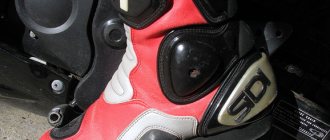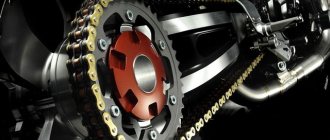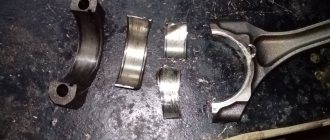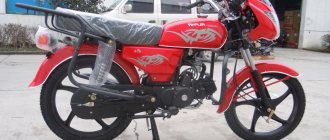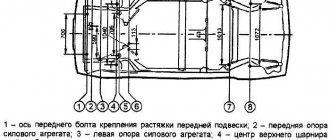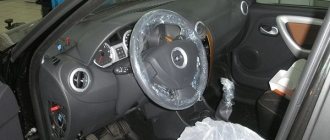Any movement on a motorcycle involves maneuvering. And maneuvering consists of dodging obstacles and, of course, turning. The experience of a motorcyclist, be it a circuit racing pilot, a professional crossman/endurist, or a first-season rider, fearfully smokin' in the outer row on an old scooter or a Chinese one bought with a fight, is determined... not by the high cost of the equipment or even the experience since obtaining a license, but by the effectiveness of braking and careful cornering.
Planning
You are planning to enter a turn. And planning should begin with determining the entry point, this is a key element in turns. On an open road or highway, select a corner entry point. It takes time and understanding to appreciate the benefits of designating such a place. Choosing such a point before each turn is much better than waiting for a turn to force it due to high speed or poor visibility. When you plan, you control the machine.
Gyroscopic effect and speed
Has it ever occurred to you why a moving motorcycle is stable, but a motorcycle standing still falls? The stability of the motorcycle is given by the gyroscopic effect created by the wheels rotating around their axis. The wheels are a powerful gyroscope, similar to a children's spinning top. Remember how, as the rotation stops, the spinning top increases its “sway” and gradually loses stability. And as soon as the spinning top stops rotating, it immediately loses its balance and falls.
A motorcycle behaves in much the same way. The gyroscopic effect resulting from the high speed of rotation of the wheel stabilizes the position of the bike. That is, high speed makes the bike stable in turns. Therefore, the higher the speed, the sharper the turn you can actually make. It should be borne in mind that at the same time as the stability of the motorcycle increases, its maneuverability decreases and it becomes more difficult for it to steer.
Tool for the motorcyclist
Turning point is when you stop braking/slow down, lean the bike (make a counter turn) and begin to accelerate smoothly. This is where you start to turn, going in a different direction. It is also a guideline for your other actions. Choosing a turning point helps keep things organized and flowing. “The entry point is a tool and like any other tool, you have to learn how to use it.” Every time you approach a turn, make sure you plan where to start the turn.
Where is the corner entry point? The answer to this question is a mystery to some people and sheds light on modern thinking about motorcycle riding. The corner entry point starts where you need to start the turn - where the straight ends and the curve begins.
Ideal track?
In books on driving techniques, we find the optimal places to enter a turn, but their authors recommend looking for an individual point at which we will feel confident. There is no single ideal entry point, and neither is the route. This is a place that you assign to yourself - after a few turns, you will know which point is the most optimal for you. The more turns you make to establish entry points, the more points you'll score on less familiar turns.
On the other hand, it's not the case that if you don't set an entry point, it doesn't exist. You always make a turn by starting the maneuver at some point. How conscious this is is another matter. Consciously deciding where to start a turn helps you organize all the elements and, as a result, enjoy a smooth and confident turn.
Awareness is important
When watching the races, you can see how accurately the racers stick to their corner entry points. It's worth starting to practice, consciously choosing the entry point into the turn. Determine where you should start turning. Find a landmark: a scratch on the asphalt, a stone, a tree, a road pole - something that is easy to notice when turning. Start your workout at a slower speed. If you don't know where to corner and lean the bike, going faster won't make it any easier. “Too often, motorcyclists try to correct fundamental mistakes by accelerating and hoping to gain speed through a corner.”
It's all about not panicking. If we don't consciously choose where to go, defensiveness and panic will do it for us. “Without a turning point, you'll ruin the whole turn. A mistake at the start of the turn will cause you to deviate from your chosen line and miss important points later.” You can see how important it is to consciously identify your turn entry point on a decreasing radius turn. You'd better delay your move and find the perfect spot. Even a wrong turn is better than nothing.
Motorcycle in a turn
Let's consider some points regarding the behavior of a motorcycle when tilted when cornering.
A single-track vehicle, which is a motorcycle, turns by tilting. We will not now analyze the ways in which you can tilt a motorcycle, there are several of them and they can be used both individually and in combination, depending on the speed of the motorcycle, its tilt angle at the current moment and the immediate task - tilting, leveling, maintaining balance in tilt or trajectory adjustment. This article is about how a motorcycle behaves when tilted, what forces influence it and how this affects the actions and comfort of the driver.
If we are talking about driving on public roads on a civilian motorcycle, then the values of inclination angles and speed values for the properties under consideration must satisfy a number of conditions:
Firstly, the speed of movement should not be much higher than the established limits. A typical accident involving motorcyclists occurs at speeds in the range of 30-80 km/h, so it is worth considering the behavior of the motorcycle at these speeds.
Secondly, safe tilt angles for a regular road motorcycle, especially in conditions of uneven or poor-quality road surfaces, should not exceed 30-40 degrees. In addition, you should always take into account the tire adhesion coefficient, which depends on their temperature, pressure, degree of wear, humidity and asphalt structure.
The main task of a motorcyclist is to travel safely from point A to point B. As speeds and angles increase, the approach to leaning and maintaining balance changes. Under the conditions under consideration, the main way to maintain balance in a tilt, the tilt itself and alignment is the force applied to the steering wheel - counter-steering. All other methods for changing the angle of the motorcycle are additional and only help to reduce the effort applied to the steering wheel, nothing more.
During a turn, while leaning, the motorcycle may tend to level out, fall over, or behave neutrally. That is, in order to maintain balance, or in this case a certain angle of inclination, the driver can apply force to the steering wheel in the direction of the turn, in the opposite direction, or not at all.
The behavior of a motorcycle in a turn can be represented by the following characteristics:
- the motorcycle maintains its lean angle without driver intervention - neutral steering;
- the motorcycle tries to level out - understeer;
- the motorcycle tends to fall into the corner - oversteer;
A motorcycle when tilted is affected simultaneously by: the moment created by the centrifugal force, which tends to reduce the angle of inclination, and the moment created by the force of gravity, which, in turn, tilts it
To simplify, let's assume that
- the motorcycle moves in a corner of constant radius at constant speed
— the gyroscopic effect is negligible
Assuming that the cross-sectional thickness of the tires is zero, moment equilibrium allows us to express the lean angle in terms of the linear speed V and the turning radius R c (the turning radius in this case is measured from the center of gravity to the turning axis):
Where Ω the angular velocity. Accordingly, linear speed is equal to the product of angular speed and turning radius: V = Ω R c
Since we are considering an example where the motorcycle is in equilibrium, the resultant of the centrifugal force and the force of gravity passes through the line connecting the points of contact of the tires with the road surface. This line lies in the plane of the motorcycle if the wheels have zero thickness and the steering angle can be neglected. In reality, the steering angle is never zero and the front contact point is slightly offset relative to the plane of the rear assembly or, in other words, the plane of the motorcycle itself, and the line connecting the contact points of the tires does not coincide with this plane. Please note that it does not coincide with the plane of the rear part of the motorcycle; take a look at the kinematic diagram of the motorcycle here. The fork, handlebar and front wheel are separate parts.
Now consider a motorcycle with tires of thickness 2 t , which describes the same turning radius R c at the same angular speed Ω . Since the thickness of the tires is not zero, the actual angle of inclination ϕ required for balance is slightly greater than the geometric one ϕi .
ϕ = ϕi + ∆ϕ
The increment ∆ϕ can be expressed by the equation
That is, the actual angle of inclination can be expressed as follows:
The equation shows that ∆ϕ increases both as the lean angle and cross-sectional radius of the tires increase, and as the height of the center of gravity h . Therefore, the use of wide tires forces the rider to use larger lean angles relative to the angle required for a motorcycle with smaller cross-section tires. Additionally, given equal tire cross-sections turning the same corner at the same speed, a motorcycle with a low center of gravity should be leaned more than a motorcycle with a higher center of gravity.
The lean angle of a motorcycle when cornering is largely dependent on the rider's position. By leaning relative to the motorcycle, the driver can thereby change the position of the center of gravity of the entire system. Let's consider the possible options. If the driver leans at the same angle as the motorcycle, the position of the center of gravity of the entire system remains unchanged.
In this case, the driver has the opportunity to adjust the angle of inclination of the motorcycle relative to the body throughout the entire turn in both directions - towards increasing the inclination and vice versa.
If the driver leans in the opposite direction of the turn, the system's center of gravity also shifts to the outside of the turn. As a result, at the same speed and with the same turning radius, he has to tilt the motorcycle a little more - ∆ α . On the one hand, this may have a negative impact on the grip, but in city traffic (up to 60-80 km/h), on a civilian motorcycle, at relatively small angles of inclination (up to 30-40 degrees), this has no effect, at least a little significant negative effect. Moreover, we should not lose sight of the fact that one of the ways to lean a motorcycle, especially at low speeds, is by working with the body, and this body position in a turn may be the result of precisely this effect of the body on the motorcycle.
If the rider leans his torso towards the inside of the turn and at the same time turns his leg so that his knee almost touches the ground, he can reduce the angle of the motorcycle. This body position allows you to significantly reduce the angle of inclination of the motorcycle when cornering or, in other words, allows you to take a turn at a higher speed in the same turn, with the same angle of inclination of the motorcycle. This technique is justified when the goal is to go through the turn faster and when there are no prerequisites for adjusting the trajectory inside the turn. In addition, adjusting the trajectory at large angles of inclination, where this body position is used, implies the use of other methods (trailbraking, emphasis on the knee)
But, let's return to the main method of changing the angle of a motorcycle - counter-steering. Counter-steering allows you to maintain balance in a straight-line motion at any speed, take the motorcycle out of balance and tilt it in the required direction, and maintain the tilted motorcycle in a state of balance. All that is required from the motorcycle driver in these conditions is to apply force to the steering wheel of different directions and strengths.
The behavior of a motorcycle when tilted depends on various geometric parameters, such as: wheelbase, offset, steering angle, wheel radii and tire cross-section radii, and on the weight distribution and stiffness of the tires. Tire properties in particular are very important since the steering angle is highly dependent on the difference between the side slip angles.
The angular speed of a motorcycle is most correctly expressed in terms of the linear speed of the rear wheel:
The denominator here is the distance from the center of the turn to the contact patch of the rear wheel.
If we assume that the wheels do not slip relative to the road surface (longitudinally, in the direction of movement), then the wheel speed ω can be expressed through the linear speed of the motorcycle V , its inclination angle ϕ and the steering angle ∆ (in this case this is the kinematic angle, not actual)
In reality, during the acceleration and braking phases, longitudinal sliding of the rear wheel always occurs. During the braking phase, significant slippage of the front wheel is observed; in conditions without acceleration and braking, slippage occurs due to rolling resistance. It is important to note that at the same linear speed, the angular speed of the wheels increases with inclination, since the distance between the contact patch and the wheel axis decreases.
Let's consider a motorcycle in a steady state of turning (neither in the process of leaning nor in the process of leveling). Under ideal conditions, the velocity vector of each wheel lies in the plane of the wheel and originates from its center. As soon as side slip begins, the vector does not coincide with the plane and an angle is formed between them, called the side slip angle λ .
When the side slip angles are zero, then the actual steering angle is equal to the kinematic angle. The ground reaction forces at the contact points of each wheel depend on the lateral sliding angles of the tires, the angle of inclination of the motorcycle and vertical loads. These forces can be expressed by the following linear expressions when the sliding and tilt angles are small
The constant k (expressed in radians-1) represents the tire stiffness coefficients
k φ deflection stiffness coefficient
kλ bending stiffness coefficient
As stiffness increases, the side slip angle decreases.
The actual steering angle ∆ * can be expressed in terms of kinematic and slip angles for the front and rear wheels:
Or through the kinematic angle and the angles of inclination of the steering column ε and the inclination of the motorcycle φ .
The turning radius described by the trajectory of the rear wheel also depends on the side slip angles and the kinematic steering angle:
Where p the wheelbase.
At small angles of inclination of the motorcycle, when the angle of rotation of the steering wheel and the angles of lateral slip of the wheels are small, you can use the formula for simplification:
That is, the turning radius (for the rear wheel) is the ratio of the wheelbase to the steering angle.
Let's return to the behavior of a motorcycle on a tilt. As mentioned above, it can tend to collapse, to level out, or remain tilted if no external forces are applied - neutral steering. The actual steering angle Δ * is equal to the kinematic steering angle Δ selected by the driver if the sideslip angles of both wheels are equal.
In this case, the steering system has “neutral” behavior, that is, if you release your hands during a turn, the motorcycle will continue to move along the given trajectory. In other cases, when the actual steering angle is greater or less than the kinematic angle, the motorcycle will tend to either fall over or level out.
Steering behavior, or in other words - steering, can be expressed using the steering coefficient ξ:
In other words, this is the ratio of the kinematic (or virtual) turning radius for the rear wheel to the actual one or the ratio of the actual steering angle to the kinematic one and depends on the ratio of the side slip angles of the front and rear wheels
If this ratio is equal to one, then the motorcycle has neutral steering. In this case, the lateral slip angles of the front and rear wheels are equal to λ f = λ r
If ξ > 1 , then the motorcycle tends to fall over and the driver needs to create force on the steering wheel to keep the motorcycle tilted. λ f > λ r is oversteer.
If ξ < 1 , then the motorcycle, on the contrary, tends to straighten out, λ f < λ r is understeer.
If a motorcycle tends to level out during a turn, then the driver needs to apply force to the steering wheel to adjust the trajectory and keep the motorcycle tilted, which causes an increase in the reaction force of the support on the front wheel. When the steering force becomes significant, the force required to maintain balance may exceed the maximum frictional force between the front tire and the road surface, causing the wheel to slip and the motorcycle to fall. A motorcycle that understeers is more dangerous than an oversteer.
Here it is necessary to clarify that all of the above applies to an equilibrium turn, that is, to a motorcycle with a constant speed and radius. In transitional motion, in a turn with changing speed and radius of curvature, the forces applied to the steering wheel will differ significantly from those calculated in the described condition, especially if changes in speed and trajectory occur suddenly. It should also be noted that as speed increases, side slip angles increase and the behavior of the motorcycle in turns may change. The direction of the forces applied to the steering wheel can also change with changes in speed. For example, on the same motorcycle at low speed the driver has to hold the steering wheel, trying to turn towards the tilt, but with increasing speed he has to change the direction of the efforts - on the contrary, turn the steering wheel away from the turn to tilt. As the angle of inclination of the motorcycle changes, the force applied to the handlebars can also change sign. Up to a certain angle of inclination, the driver has to steer away from the turn, overcoming the resistance of the motorcycle (understeer), and after passing this angle, on the contrary, apply force in the direction of the turn, overcoming oversteer.
The amount of force (not sign) applied to the steering wheel depends on many parameters, including the geometric features of the motorcycle. The table below shows these parameters and the approximate degree of their influence on steering effort:
(+) The steering angle tends to decrease. To neutralize this effect, the driver must turn the steering wheel in the direction of the turn. If the force was directed in the opposite direction, then its value becomes less.
( — ) The steering angle tends to increase. The driver must steer away from the turn to counteract. With this direction of effort, its value increases.
When driving on public roads, a motorcycle must have a sufficient margin of lean angle and tire adhesion coefficient with the road surface. The speed and angle of the motorcycle must be such that the driver has the opportunity not only to avoid falling in a turn, but also to stop in it, if necessary.
Text: Motoshkola.ru Vittore Cossalter
Efficient and safe cornering
How to determine the entry point into a turn? We advise you not to focus on the inside of the turn - this can lead to us entering the turn too early and ending up on the outside edge at the exit. There is a possibility that we may go off the road. You will have to drive longer in the assembly to complete the maneuver. We also need to be patient before a corner - uncertainty about speed, what's around the corner and how it will go overall can lead to premature failure of the bike. Patience will pay off - you'll see what's around the corner faster and get out of it faster.
Although the build ride is often the most exciting experience for a motorcyclist, it should be kept as short as possible. Entering a corner too early will cause you to ride lean for longer and may limit your visibility of what's around the corner. Entering a corner too late may, in turn, require you to lean more into your approach, make an adjustment, hit the throttle, or turn again. Unfortunately, only minor adjustments are possible when cornering, and each of them carries additional risk.
As you can see, we always need to choose a corner entry point - regardless of whether we are driving along the highway or not. Going from one place to another is not the same as a highway where the turns are predictable, clean and empty. When driving on the street or outside the city, you should consciously choose an entry point for a turn that is adapted to the road conditions, weather and speed.
Post Views: 522
Motorcycle turns and steering
And the third main mistake is steering. Usually we only do one main steering when turning. That is, we are, as a rule, at maximum lean in a turn once. After this we straighten up. And steering is a sign that we are not looking far enough into the turn. And you have to taxi to fit in. The problem with this is that you have to tilt the motorcycle several times. And while leaning, we cannot accelerate or brake normally. Therefore, it is best to minimize the number of maximum tilts during a turn and make do with one.
These are the three main errors along the turning path. Individually, of course, they are not so scary, but when two or three are combined, you can get an unpleasant situation. Therefore, you need to carefully monitor the trajectory and not leave this matter to instincts. Our instincts usually work against us when riding a motorcycle.
